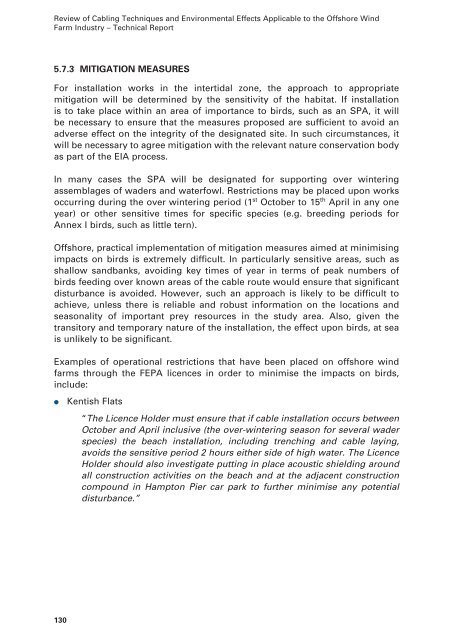Review of Cabling Techniques and Environmental Effects Applicable
Review of Cabling Techniques and Environmental Effects Applicable
Review of Cabling Techniques and Environmental Effects Applicable
Create successful ePaper yourself
Turn your PDF publications into a flip-book with our unique Google optimized e-Paper software.
<strong>Review</strong> <strong>of</strong> <strong>Cabling</strong> <strong>Techniques</strong> <strong>and</strong> <strong>Environmental</strong> <strong>Effects</strong> <strong>Applicable</strong> to the Offshore Wind<br />
Farm Industry – Technical Report<br />
5.7.3 MITIGATION MEASURES<br />
For installation works in the intertidal zone, the approach to appropriate<br />
mitigation will be determined by the sensitivity <strong>of</strong> the habitat. If installation<br />
is to take place within an area <strong>of</strong> importance to birds, such as an SPA, it will<br />
be necessary to ensure that the measures proposed are sufficient to avoid an<br />
adverse effect on the integrity <strong>of</strong> the designated site. In such circumstances, it<br />
will be necessary to agree mitigation with the relevant nature conservation body<br />
as part <strong>of</strong> the EIA process.<br />
In many cases the SPA will be designated for supporting over wintering<br />
assemblages <strong>of</strong> waders <strong>and</strong> waterfowl. Restrictions may be placed upon works<br />
occurring during the over wintering period (1 st October to 15 th April in any one<br />
year) or other sensitive times for specific species (e.g. breeding periods for<br />
Annex I birds, such as little tern).<br />
Offshore, practical implementation <strong>of</strong> mitigation measures aimed at minimising<br />
impacts on birds is extremely difficult. In particularly sensitive areas, such as<br />
shallow s<strong>and</strong>banks, avoiding key times <strong>of</strong> year in terms <strong>of</strong> peak numbers <strong>of</strong><br />
birds feeding over known areas <strong>of</strong> the cable route would ensure that significant<br />
disturbance is avoided. However, such an approach is likely to be difficult to<br />
achieve, unless there is reliable <strong>and</strong> robust information on the locations <strong>and</strong><br />
seasonality <strong>of</strong> important prey resources in the study area. Also, given the<br />
transitory <strong>and</strong> temporary nature <strong>of</strong> the installation, the effect upon birds, at sea<br />
is unlikely to be significant.<br />
Examples <strong>of</strong> operational restrictions that have been placed on <strong>of</strong>fshore wind<br />
farms through the FEPA licences in order to minimise the impacts on birds,<br />
include:<br />
●<br />
130<br />
Kentish Flats<br />
“The Licence Holder must ensure that if cable installation occurs between<br />
October <strong>and</strong> April inclusive (the over-wintering season for several wader<br />
species) the beach installation, including trenching <strong>and</strong> cable laying,<br />
avoids the sensitive period 2 hours either side <strong>of</strong> high water. The Licence<br />
Holder should also investigate putting in place acoustic shielding around<br />
all construction activities on the beach <strong>and</strong> at the adjacent construction<br />
compound in Hampton Pier car park to further minimise any potential<br />
disturbance.”
















